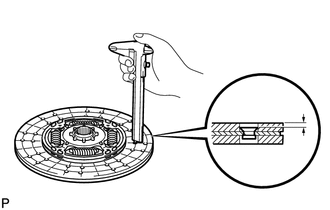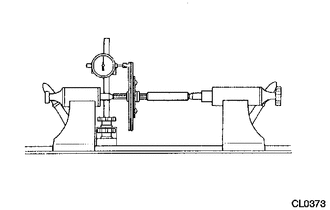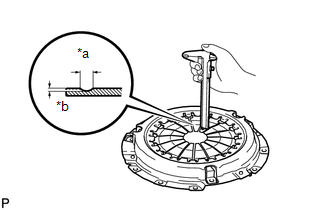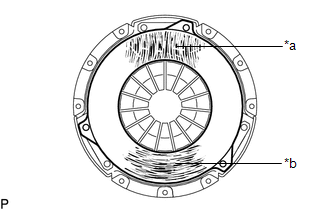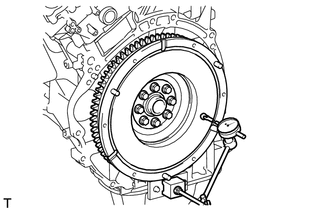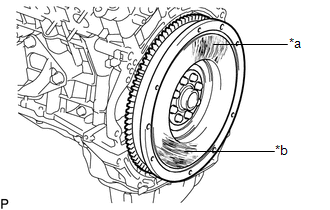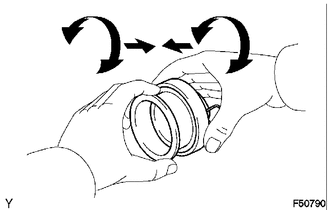Toyota Tacoma (2015-2018) Service Manual: Inspection
INSPECTION
PROCEDURE
1. INSPECT CLUTCH DISC ASSEMBLY
NOTICE:
When replacing the clutch disc assembly, make sure to perform an inspection of the flywheel sub-assembly and clutch cover assembly.
|
(a) Using a vernier caliper, measure the rivet depth. Minimum rivet depth: 0.3 mm (0.0118 in.) If the depth is less than the minimum, replace the clutch disc assembly. |
|
|
(b) Using a dial indicator, measure the clutch disc assembly runout. Maximum runout: 0.7 mm (0.0276 in.) If the runout is more than the maximum, replace the clutch disc assembly. |
|
2. INSPECT CLUTCH COVER ASSEMBLY
|
(a) Using a vernier caliper, measure the depth and width of the diaphragm spring wear. Text in Illustration
Maximum Wear:
If the depth or width is more than the maximum, replace the clutch cover assembly. |
|
|
(b) Perform a visual inspection of the clutch cover assembly. Text in Illustration
(1) Inspect for hair cracks or scratches extending from the center outwards, or discoloration. (2) Inspect for hair cracks in a circular pattern, discoloration or excessive wear. If there is any damage, replace the clutch cover assembly. |
|
3. INSPECT FLYWHEEL SUB-ASSEMBLY
|
(a) Using a dial indicator, check the flywheel sub-assembly runout. Maximum runout: 0.1 mm (0.00393 in.) If the runout is more than the maximum, replace the flywheel sub-assembly. |
|
|
(b) Perform a visual inspection of the flywheel sub-assembly. Text in Illustration
(1) Inspect for hair cracks or scratches extending from the center outwards, or discoloration. (2) Inspect for hair cracks in a circular pattern, discoloration or excessive wear. If there is any damage, replace the flywheel sub-assembly. |
|
4. INSPECT CLUTCH RELEASE BEARING ASSEMBLY
|
(a) Check that the clutch release bearing assembly moves smoothly without abnormal resistance by turning the sliding parts of the clutch release bearing assembly (contact surfaces with the clutch cover assembly) while applying force in the axial direction. |
|
(b) Inspect the clutch release bearing assembly for damage or wear.
If necessary, replace the clutch release bearing assembly.
 Components
Components
COMPONENTS
ILLUSTRATION
...
 Removal
Removal
REMOVAL
PROCEDURE
1. REMOVE MANUAL TRANSMISSION ASSEMBLY
(See page )
2. REMOVE CLUTCH RELEASE FORK SUB-ASSEMBLY
(a) Remove the clutch release fork sub-assembly with the clutch releas ...
Other materials:
Installation
INSTALLATION
CAUTION / NOTICE / HINT
PROCEDURE
1. INSTALL REAR AIRBAG SENSOR LH
(a) Check that the ignition switch is OFF.
(b) Check that the cable is disconnected from the battery negative (-) terminal.
CAUTION:
After disconnecting the cable from the terminal, wait for at least 90 seconds
...
Removal
REMOVAL
CAUTION / NOTICE / HINT
HINT:
Use the same procedure for the RH and LH sides.
The procedure listed below is for the LH side.
PROCEDURE
1. REMOVE REAR DOOR FRAME GARNISH
(See page )
2. REMOVE REAR DOOR INSIDE HANDLE BEZEL PLUG
(See page )
3. REMOVE REAR ARMREST ...
Parts Location
PARTS LOCATION
ILLUSTRATION
*A
w/ Fog Light
*B
w/ Automatic High Beam System
*C
for Manual Transmission
-
-
*1
HEADLIGHT ASSEMBLY LH
*2
HEADLIGHT ASSEMB ...

